This article intends to provide a brief overview of what all the talk about Snowflake Native Apps Marketplace is about, how organizations can utilize the space to monetize their offerings, and how consumers can benefit from these third-party off-the-shelf applications, ending with detailed instructions to help new users navigate to and around the Native Apps Marketplace.
Beginner to Snowflake? A Quick Explanation
Touted as an entity that houses “Virtual Warehouse” with SQL capabilities built for the cloud, Snowflake has become one of the leading game-changers when it comes to platforms providing cloud-based services. Right since its entry into the cloud services domain, Snowflake has grabbed eyeballs with its one-of-a-kind capabilities. Operating with a pricing structure that separates compute and storage costs, the platform allows scaling up and down flexibly depending on the requirements of the users and their queries.
Snowflake soon gained its place in the industry as a cost-efficient solution that caters to the “data needs” of organizations that want a clean way to load, store and analyze massive amounts of data. A couple of unique things that Snowflake allows its users to do which are not facilitated by traditional data warehouses:
- Firstly, Snowflake allows the storage and querying of semi-structured and unstructured data in its databases (which is not so special). HOWEVER, it allows users to query that data using SQL. So, if you’re a SQL enthusiast, yay! You can easily store data in formats such as JSON, Avro, XML under the “Variant” datatype, just as you would store an integer data type column in a relational database, and query it using simple SELECT statements in SQL.
- Snowflake allows you to “Time Travel” i.e., it allows users to query data that had been deleted or altered in the past. With retention spans ranging from 1-90 days, depending upon the chosen storage plans, this provides a great way of analyzing historical data in comparison with the current results.
The above mentioned features are just a sample that shows how Snowflake is so similar, yet offers so many other features, such as allowing users to “Undrop Tables,” that is not possible in traditional data warehouses. What’s more? Snowflake is constantly on the go, with more such incredible features being introduced almost every periodic release.
Now that you’ve grasped a basic idea of what Snowflake is all about, let’s dive deeper into what the Snowflake Marketplace offers.
Snowflake Marketplace: Platform to Access and Publish Third Party Data Products
Snowflake Marketplace is a centralized space on the platform that allows third party providers to come up with and publish their own data product offerings to the entire Snowflake Data Cloud. This paves the way for a two-way benefit: Providers now have a way of showcasing their offerings to multiple consumers at once, along with a provision of providing a sample of their service offerings and charge users if they want complete access, thus having a chance of revenue generation.
Providers have two options ways of offering their products:
- Showcase data that can be shared with their consumers that would aid them in making optimized business decisions in combination with existing organization data. Owners of the data can publish their dataset for free or provide a free sample and charge for access to the complete dataset.
- Provide pre-configured applications running on their own Snowflake account that consumers can simply access.
On the other hand, consumers will also reap the fruits of this arrangement:
- They can access raw datasets that they can transform and perform analysis in combination with their own organizational data for free. A key benefit of this arrangement is that while consumers do gain access to the database, it isn’t a static version of the dataset that they use. Instead, Snowflake employs the concept of “shared datasets,” through which the database is shared from the provider’s account and appears alongside your existing databases. This feature allows consumers to have access to the most recent version of the data. Any queries run by the consumers on the database directly reference the provider’s original objects, thus eliminating the risk of providing outdated results.
- Users also have a choice of plenty of business intelligence applications sans the hassle of configuring and maintaining them, right at their fingertips. These BI applications are available under the Snowflake Native Apps umbrella in Snowflake Marketplace. The main advantage of this provision is an assurance of trust and security for the consumer data, as any of their data flowing through the app never reaches the provider.
To further strengthen this superficial understanding of the layout of Snowflake Marketplace, let’s look at a step-by-step demonstration of both these options for consumers.
Shared Datasets: Run Queries on Data Located in Databases of Third-Party Snowflake Accounts
Accessing third-party datasets from your org’s Snowflake account is a piece of cake, literally!
- Choose the Marketplace option under Data Products category:
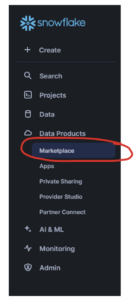
- If you are just exploring the platform, you can find a number of datasets that are publicly available and are being installed by most consumers in the “Most Popular” section. Click on the “More” option:
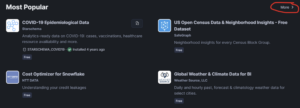
- Once you click the “More” option, you can see a variety of the most trending applications and datasets. Choose any one of the free datasets of your choice. For demonstration purposes, I am choosing the COVID-19 Epidemiological Data, which is a free dataset that is being offered on the platform:
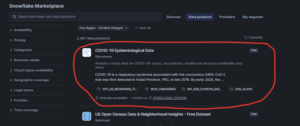
- Once you land on the home page of the product, you can get a brief overview of the database, including the data dictionary and a few example queries of how the data can be used for analysis. Once you are satisfied with the information provided and ready to proceed, click on “Get” to access the dataset. Quick warning: You need to have the necessary privileges to get the dataset into your Snowflake account. Contact your account administrator to find out if you have the needed privileges.
- Once access is provided, you can simply access the dataset by clicking on the “Open” option on the dataset’s landing page, or you can simply find it by searching under the “Databases” pane:

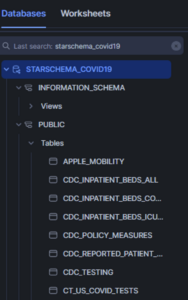
- You can now run your queries on the database just as you would do on any existing database in your organization. I have demonstrated a sample query below for this purpose:
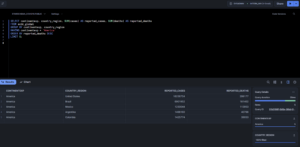
Snowflake Native Apps: Run Third-Party Apps in Your Org’s Snowflake Account
Navigating Native Apps in Snowflake is pretty simple, similar to how you navigate to find shared datasets. The screenshots below showcase step-by-step instructions to do so.
- Choose the Marketplace option under Data Products category:
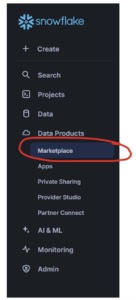
- Once you land on the Snowflake Marketplace page, scroll down to Native Apps. Select the “Click here for more” option:

- If you already know what you want, you can simply do a search to access the specific application. However, if you are just looking around for different options that are available, Snowflake offers several options to help you filter down the products and choose the most optimal solution for your business needs:
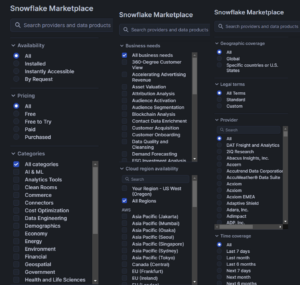
- To demonstrate this, I am searching for offerings from Snowflake, which you can simply do by searching in the Provider filter itself:
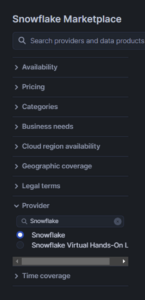
- Once the applications offered by Snowflake are displayed, you can simply choose the one your organization requires, know more about the application, determine whether it suits your business needs and access it from your Snowflake account. Here, I have chosen the Snowflake Data Clean Rooms:
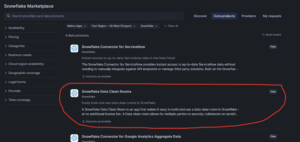

Conclusion
Remember, although Snowflake Marketplace offers several products in the form of both datasets and third-party applications to choose from, not all of them are free. Most of them do offer a sneak peek into the products by allowing users to access trail versions. Ultimately, it depends on your organization’s requirement, scope of analysis and the budget.
Now that you have seen what Snowflake’s Marketplace goldmine offers, wait no more and start exploring!

